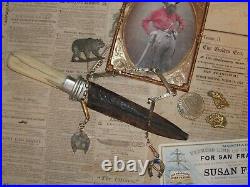
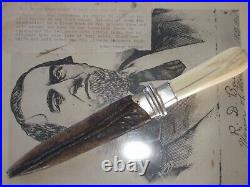
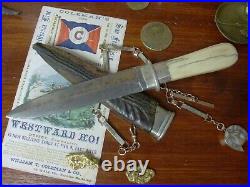
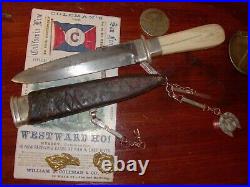
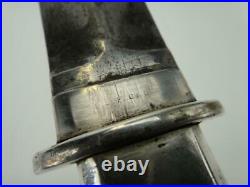
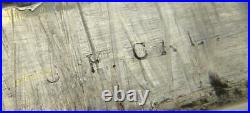
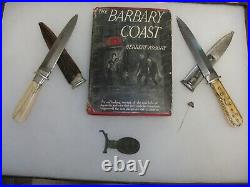
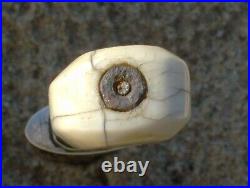
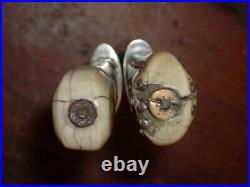
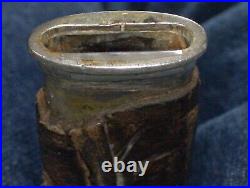
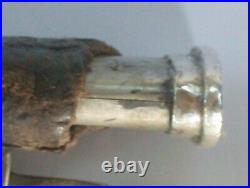
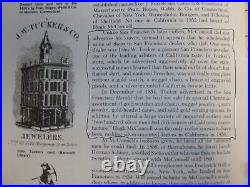

Made in Gold Rush era San Francisco, this early, California, silver-mounted dirk knife may, or may not, be the oldest San Francisco made dirk knife known. Proving it one way or the other would be a real challenge. If I had more info. That could date the knife before 1854 it would be priceless. Could it “possibly” be an early, unmarked, Hugh McConnell knife? (SEE THE LAST IMAGE IN THE PICTURE GALLERY). No one knows when he arrived in California but according to Levine’s book Hugh McConnell was making his knives in S. The article in Levine’s book could help to explain the Jewelers stamp on this knife. I’m not saying this is, or isn’t, a McConnell knife but there are some very different and unique things about this particular knife that sets it apart from “all” of the other known San Francisco knives and it sure makes you wonder. And it’s – obviously – a very old knife. Regarding a question about the white handle, a reliable expert & dealer in this natural material is quoted at bottom next to the. The provenance that came with this knife has a note pasted to the photo that mentions a “silver knife” that belonged to a gold seeker named R. Baugh who traveled to California to find gold. This knife is 9-3/8″ with a 5-1/2″ blade and comes with it’s original silver sheath with stepped throat and period leather over-sheath. The provenance is an old 8″x 10″ photograph of an etching of R. Baugh who later became mayor of Memphis Tenn. From 1857 to 1861. The photograph and note is, I believe, c. Late 1800’s and not later than 1920’s. The back has a short history of the photo penned in old iron ink. This photograph of your great Uncle Richard D. Baugh was made from a negative from an engraving of him in a book – hence the markings on his face……. According to an online search, during the Civil War he served as a Col. In the 7th TN. The provenance can’t prove that this knife is the one mentioned in the note but if we dismiss the provenance and evaluate the knife by itself it would reasonably date to around the 1850’s to 1860’s. But taking into account that the provenance is old and mentions a silver knife that belonged to a gold seeker, and it’s early construction design, and the rare stamp associating it directly to San Francisco I have to assume that the knife and provenance belong together. Levine’s: “Knifemakers of Old San Francisco” There was only one other inconsequential knifemaker in S. In 1852 besides Hugh McConnell. But, there were a total of seven great fires in San Francisco from 1849 to 1851 which may have wiped out any previous records of knife making in the city. There is no makers identification on the knife but there is a fascinating, unique, stamp on the silver band around the riccasso: S. , in tiny letters not much bigger than 1/32 of an inch. It looks like a jewelers stamp or a silversmith stamp. I had to have a friend with macro photography equipment take a good picture of it. This great stamp renders the knife an inescapable part of the California Gold Rush. Please see the last image in the gallery (from “Knife Makers of Old San Francisco”) for an interesting piece on Hugh McConnell. It explains the possible reason for the jewelers stamp. NOTE: Included with the knife is an extremely rare San Francisco newspaper (“THE GOLDEN ERA / March 12, 1854″) with a historical, early knife maker ad for “Hugh McConnell”. McConnell was the earliest known knife maker in S. And the ad is probably the only one like it. There are only a few other similar Hugh McConnell ads known but this particular ad has more meat than the other ads that only have three lines with no mention of Bowie knives or dirk knives. This ad has 12 lines beneath the word “CUTLER”. Two lines say: “Will make to order”…. “Bowie knives of the best quality / mounted with either gold or silver”. Construction: The silver sheath was finished in-the-rough revealing the seams and joints as you can see in the last two images. It would probably be very hard to find any sheath made for the high quality San Francisco knives that didn’t have a silver plated finish to hide the seams and joints. This is probably a good indication of a very early make. Also the round nut secured to the tang is iron, or steel, and is not the silver slotted type of nut usually seen on the S. These construction differences might be expected on a knife made in the very early 1850’s before the new & improved versions were developed. Overall Condition is very good. The blade is full but in used condition. The handle has dark, hairline cracks. The silver mounts have scratches and the flush mounted nut on the end has heavy rust. The sheath is covered with a heavy-duty, hand tooled and hand stitched, leather over-sheath that is definitely of the period. The old brown leather is beautifully worn from use and has a gorgeous old western frontier look. The stitching is strong and completely intact. The only thing is that the leather has shrunk tight around the sheath so you can’t see the rest of the sheath and taking it off is not possible without destroying it so it’s best left on. There’s been a question about the color of the handle material and whether or not it’s the original handle. I emailed two qualified collectors & dealers in this natural material and both agree that the white color would be consistent with the age as described. It’s tapioca-white color does show sufficient age but hasn’t yellowed as have many examples of S. Knife handles see M. Price knife, #8 in picture gallery since the 1800’s. Perhaps contacting a carbon dating company and see about having it carbon dated. Stored properly, with humidity control and heat control, it will hardly age at all. If left in the sun, exposed to oils or chemicals, or kept in a hot dry place, it will crack, yellow, and pit. But if it were say, in a trunk wrapped in a clothe inside a house, it might crack but not yellow. So, again there are so many variables. I own” examples “I know are from the 1800’s that are snowy white. This explanation would be consistent with the provenance that this knife was kept as a treasured heirloom and passed down through the family and was probably stored in the proper way. So, though it may have cracked it would have maintained a white color and not yellowed over time. The item “Antique American Bowie/Dirk knife California gold rush San Francisco” is in sale since Thursday, September 17, 2020. This item is in the category “Collectibles\Cultures & Ethnicities\Western Americana\Antique Western”. The seller is “atthediggings” and is located in Honolulu, Hawaii. This item can be shipped worldwide.

